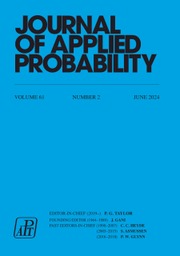Crossref Citations
This article has been cited by the following publications. This list is generated based on data provided by
Crossref.
Montgomery, M.
and
De Veciana, G.
1996.
On the relevance of time scales in performance oriented traffic characterizations.
Vol. 2,
Issue. ,
p.
513.
Duffield, N. G.
1996.
Economies of scale in queues with sources having power-law large deviation scalings.
Journal of Applied Probability,
Vol. 33,
Issue. 03,
p.
840.
Liu, Zhen
Nain, Philippe
and
Towsley, Don
1997.
Exponential bounds with applications to call admission.
Journal of the ACM,
Vol. 44,
Issue. 3,
p.
366.
Duffield, N.G.
1997.
Economies of scale for long‐range dependent traffic in short buffers.
Telecommunication Systems,
Vol. 7,
Issue. 1-3,
p.
267.
Duffield, N.G.
1998.
Queueing at large resources driven by long-tailed M/G/∞-modulated processes.
Queueing Systems,
Vol. 28,
Issue. 1-3,
p.
245.
Likhanov, N.
and
Mazumdar, R.R.
1998.
Cell loss asymptotics in buffers fed with a large number of independent stationary sources.
Vol. 1,
Issue. ,
p.
339.
Toomey, Fergal
1998.
Bursty traffic and finite capacity queues.
Annals of Operations Research,
Vol. 79,
Issue. 0,
p.
45.
Ephremides, A.
and
Hajek, B.
1998.
Information theory and communication networks: an unconsummated union.
IEEE Transactions on Information Theory,
Vol. 44,
Issue. 6,
p.
2416.
Courcoubetis, Costas
Siris, Vasilios A.
and
Stamoulis, George D.
1998.
Application and evaluation of large deviation techniques for traffic engineering in broadband networks.
p.
212.
Duffield, N.G.
1998.
Conditioned asymptotics for tail probabilities in large multiplexers.
Performance Evaluation,
Vol. 31,
Issue. 3-4,
p.
281.
Duffield, N.G.
and
Low, S.H.
1998.
The cost of quality in networks of aggregate traffic.
Vol. 2,
Issue. ,
p.
525.
Heyman, Daniel P.
1998.
Some issues in performance modeling of data teletraffic.
Performance Evaluation,
Vol. 34,
Issue. 4,
p.
227.
Courcoubetis, C.
Kelly, F. P.
Siris, V. A.
and
Weber, R.
1998.
Broadband Communications.
p.
209.
Courcoubetis, Costas
Siris, Vasilios A.
and
Stamoulis, George D.
1998.
Application and evaluation of large deviation techniques for traffic engineering in broadband networks.
ACM SIGMETRICS Performance Evaluation Review,
Vol. 26,
Issue. 1,
p.
212.
1999.
Charging Communication Networks.
p.
217.
Courcoubetis, Costas
Siris, Vasilios A.
and
Stamoulis, George D.
1999.
Application of the many sources asymptotic and effective bandwidths to traffic engineering.
Telecommunication Systems,
Vol. 12,
Issue. 2-3,
p.
167.
Courcoubetis, C.
Dimakis, A.
and
Stamoulis, G.D.
1999.
Traffic equivalence and substitution in a multiplexer.
p.
1239.
Likhanov, Nikolay
and
Mazumdar, Ravi R.
1999.
Cell loss asymptotics for buffers fed with a large number of independent stationary sources.
Journal of Applied Probability,
Vol. 36,
Issue. 1,
p.
86.
Likhanov, Nikolay
and
Mazumdar, Ravi R.
1999.
Cell loss asymptotics for buffers fed with a large number of independent stationary sources.
Journal of Applied Probability,
Vol. 36,
Issue. 01,
p.
86.
Karasaridis, A.
and
Hatzinakos, D.
1999.
Bandwidth allocation bounds for α-stable self-similar Internet traffic models.
p.
214.

